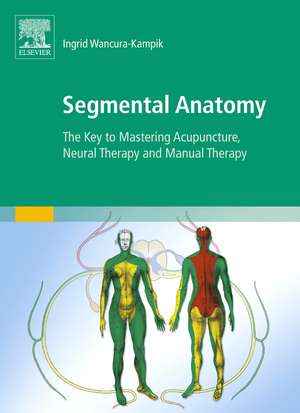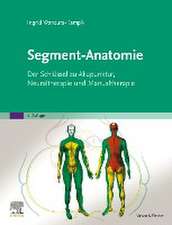Segmental Anatomy: The Key to Mastering Acupuncture, Neural Therapy and Manual Therapy
Autor Ingrid Wancura-Kampiken Limba Engleză Paperback – 24 aug 2012
Formidably illustrated and written, the correlations between spinal nerves and segments in skin, musclar system and bones as well as the projection areas of internal organs on the body surface area are deduced from the anatomy of the nervous system. These correlations between spinal nerves and the periphery of the body explain how acupuncture, neural, and manual therapies take effect . Great accessibility through:
- Full colour images
- Drawings that depict the correlations in detail
- Cearly structured layout facilitating the reading of this complex subject
Preț: 435.09 lei
Preț vechi: 585.54 lei
-26% Nou
83.26€ • 86.82$ • 69.20£
Carte disponibilă
Livrare economică 21 februarie-07 martie
Livrare express 13-19 februarie pentru 116.23 lei
Specificații
ISBN-10: 0702050423
Pagini: 384
Ilustrații: 124 illustrations (124 in full color)
Dimensiuni: 196 x 270 x 28 mm
Greutate: 1.22 kg
Editura: Elsevier
Cuprins
1
Segmentation and Metamerism 1 What is a Segment? 1 The Significance of Segments 7
2
The Role of the Peripheral Spinal Nervous System in Segmentation 1 The Spinal Nerves 4 The Branches of the Spinal Nerves 15 The Three Spinal Nerve Branches As the Basis of the Threefold Longitudinal Division of the Body Surface 18 The Branches of the Spinal Nerves in Detail 32 The Dorsal Branches of the Spinal Nerves 32 The Dorsal Branches in Psychosomatic Medicine and Evolution 37 The Ventral and Lateral Spinal Nerve Branches and Plexuses 41 Plexus Formation from the Point of View of Segmental Anatomy 42 The Individual Plexuses 47 The Pre- and Postaxial Lines, Basis of the Meridian-"Lines" 70
3
The Role of the Peripheral Autonomic Nervous System in Segmental Theory 1 Anatomy 2 The Peripheral Sympathetic Nervous System and Its Role in Segmental Theory 4 The Origins of the Sympathetic Nervous System 5 Sympathetic Innervation of the Limbs 6 Sympathetic Effects on the Dilator Pupillae Muscle and on the Effector Organs of the Integument 7 Sympathetic Supply to the Head, Neck, and Limbs 10 The Efferent Sympathetic Nerves 12 The Afferent Sympathetic Nerve Pathways 33 The Large Sympathetic Ganglia and Their Projections onto the Skin 38 The Peripheral Parasympathetic Nervous System and Its Role in Segmental Theory 46
4
The Dermatomes 1 Radicular Innervation of the Integument 1 Clinical Relevance 2 Parts of a Dermatome 4 The Sensory and Autonomic-Motoric Dermatomes 6 Sensory Dermatomes 6 Autonomic-Motoric Dermatomes 8 Physiological Hyperesthesia 9 The Maximum Points of the Dermatomes 9 The Maximum Areas of the Dermatomes 13 The Hiatus Lines 14 Individual Dermatome Groups, Extent and Shape, Interactions, and "Autonomic Facial Expression" 17 Dermatomes of the Head and Neck 17 Dermatomes of the Trunk T1 to T12 25 The Lumbar and Sacral Dermatomes 29 Dermatoses and Segmentation 30
5
The Myotomes 1 Radicular Innervation of the Muscles 1 Metameric Order of the Myotomes 2 Herringham's Rules of Location and Distribution of Myotomes in the Muscles 3 The Muscles of the Upper and Lower Limbs and Their Corresponding Myotomes 6 The Individual Myotome Groups 7 The Cervical Myotomes 7 The Thoracic Myotomes (T 1 to T 12) 24 The Lumbo-Sacral Myotomes 34
6
The Sclerotomes 1 Radicular Innervation of the Bones 1 The Spinal Column and Its Segmental Relations 4 The Individual Sclerotomes 6 The Sclerotomes of the Upper Limb and the Shoulder Girdle 6 The Sclerotomes of the Lower Limb and the Pelvis 8
7
The Enterotomes 1 "Transformation" of Internal Organs into Enterotomes 4
8
Conduction of Impulses Betweeen Segments* 1 Multisynaptic, Proprioceptive, and Viscerogenic Reflexes 1
9
Referred Pain 1 Pain Projected to the Body Surface in Visceral Disease 1 Projected Symptoms 4 On the Location of Projected Symptoms 9 Clinical Significance of Projected Symptoms 9 Algetic Symptoms 10 Hyperalgesia and Hyperesthesia of the Cutis and Subcutis (Head Zones) 12 Hyperalgia of Muscles and Tendons (Mackenzie Zones) 14 Comparison of Pseudoradicular Syndromes, e.g., Radiation of Pain from a Joint Capsule (Fig. 9.4) and Referred Pain (Fig. 9.3) 18 Autonomic-Reflexive Symptoms 21 Autonomic Effects in the Integument 22 Effects on the Head 27 Effects in the Shoulder 35 Asymmetry of Posture and Movement 36 Reflexive and Algetic Spinal Column Syndromes 37 Asymmetry of Proprioceptive and Multisynaptic Reflexes 38 Autonomic Organ Reflexes (Viscero-Visceral-Reflexes) 40
10
The Visceral Organs-the Enterotomes from the Viewpoint of Segmental Anatomy 1 Interactions and Projectional Phenomena 1 The Heart: Algetic and Autonomic-Reflexive Areas of Projection 2 Lungs and Bronchi: Their Algetic and Autonomic-Reflexive Projectional Fields 14 The Esophagus: Algetic and Autonomic-Reflexive Projectional Fields 21 Stomach and Duodenum 26 Small Intestine (Jejunum, Ileum) 32 Cecum, Appendix, Ascending and Transverse Colon 34 Descending Colon, Sigmoid Colon, and Rectum 37 Kidney, Bladder, Ureter-Their Algetic and Autonomic-Reflexive Projectional Fields 41 The Genital Tract: Its Algetic and Autonomic-Reflexive Projectional Fields 47 Testes, Uterus, Ovaries: Their Algetic and Autonomic-Reflexive Projectional Fields 50 Prostate Gland: Its Algetic and Autonomic- Reflexive Projectional Fields 51 Liver and Gallbladder: Algetic and Autonomic-Reflexive Projectional Fields 53 Pancreas and Spleen: Their Algetic and Autonomic-Reflexive Projectional Fields 57 Occurrence of Reflexive and Algetic Symptoms in Other Disorders 58






















